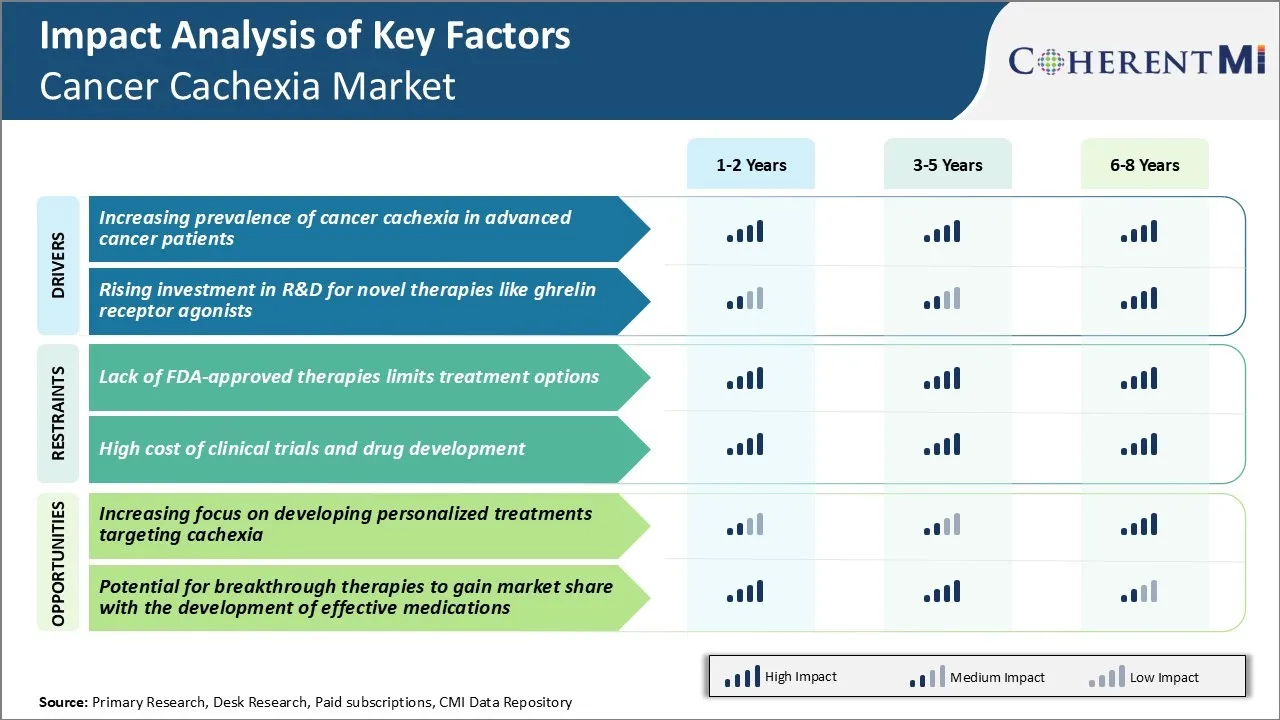Cancer Cachexia Market Trends
Market Driver - Increasing Prevalence of Cancer Cachexia in Advanced Cancer Patients
The number of patients suffering from advanced and metastatic forms of cancer has been steadily increasing over the years. One of the major co-morbidities associated with advanced cancer is cachexia. Cachexia leads to muscle wasting through various mechanisms induced by cancer itself or chemotherapy and radiotherapy undergoing treatment.
Concurrently, cancer often causes malabsorption and disruption of normal metabolic pathways reducing appetite and food intake in patients. With modern advances in cancer screening and diagnostics coupled with effective targeted and immunotherapies, many patients are able to survive longer periods even after advanced stage diagnosis. However, prolonged survival also means patients have to cope with cancer for extended durations which increases their likelihood of developing cachexia.
Moreover, supportive and palliative care approaches also now allow many non-curable patients to live with manageable symptoms leading to rising prevalence of cachexia in advanced cancer populations. Therefore, with increasing cancer incidence and improved survival rates especially in developed nations, cachexia attributable morbidities are projected to grow significantly. This poses a serious treatment challenge necessitating novel therapeutic avenues for cancer cachexia.
Market Driver - Rising Investment in R&D for Novel Therapies like Ghrelin Receptor Agonists
Major pharmaceutical companies and small biotechs have started dedicating larger funds and resources in past decade to develop effective therapies targeting cancer cachexia. Currently, there are no approved drugs specific for cachexia indication and management involves off-label usage of common appetite stimulants or steroids.
However, these drugs provide limited benefits and are often associated with severe side effects especially upon long term usage. This unmet clinical need has spurred extensive research into molecular mechanisms underlying cachexia pathology. One such promising target attracting substantial industry interest is ghrelin signaling pathway.
Ghrelin is an orexigenic hormone normally produced in stomach which plays a key role in regulating appetite and metabolic functions. Studies showed ghrelin levels significantly reduced in cachectic cancer patients. Preclinical research validated ghrelin receptor agonist’s ability to reverse muscle wasting, increase food intake and body weight in various rodent cachexia models. This provided strong rationale for developing ghrelin analogues as anti-cachectic drugs, contributing to the growth of the cancer cachexia market.

Market Challenge - Lack of FDA-approved Therapies Limits Treatment Options
The cancer cachexia market faces significant challenges due to the lack of FDA-approved drug therapies specifically indicated for the treatment of cancer-related weight loss and muscle wasting. Currently, there are no drugs approved by the FDA for the treatment of cachexia associated with cancer or other chronic wasting diseases.
The only options available are mainly appetite stimulants or corticosteroids prescribed off-label, which have limited efficacy and come with significant safety risks when used long-term. This leaves oncologists and patients without adequate therapeutic alternatives for effectively managing cachexia. The lack of approved therapies also hinders efforts among pharmaceutical companies to invest further in research and development towards more effective and safer cachexia treatments.
More clinical research initiatives and collaborations between drug developers are needed to better understand the pathophysiology of cachexia and identify promising drug candidates that can obtain regulatory approval and transform patient care.
Market Opportunity - Increasing Focus on Developing Personalized Treatments Targeting Cachexia
The growing awareness and understanding of cancer cachexia presents attractive opportunities for companies operating in this market. There is an increasing focus in the oncology space on developing more personalized treatments that address the specific biological mechanisms underlying individual patients' cancer cachexia.
Several biotech companies and large pharmaceutical firms are engaged in clinical trials evaluating novel compounds targeting multiple cachexia pathways, such as inflammation, metabolic dysregulation and anorexia. They are also exploring opportunities for combinations with existing oncology medicines. This pipeline of potential new therapies has generated optimism that more safe and effective options for cachexia management can be made available in the near future.
As research in biomarkers and personalized screening of cachexia progresses, pharmaceutical firms may also be able to identify patient subgroups most likely to respond to certain targeted treatments. Such precision approaches could help optimize development of therapies and achieve better clinical outcomes in cancer cachexia.